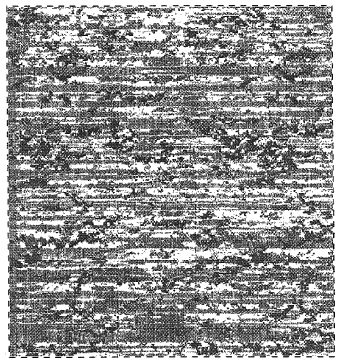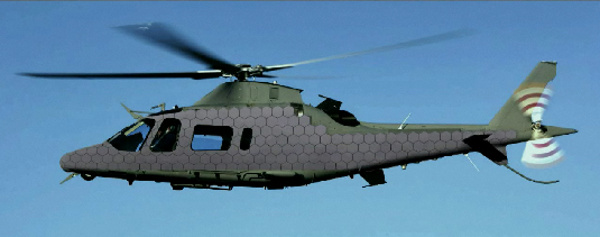Camouflage
October 4, 2011
Peek-a-boo is a game that mothers play with their babies. The mother hides her face, then she reveals herself to the baby, saying, "Peekaboo! I see you!" Babies, and probably mothers, think this is great fun.
The reason for this is that before eight or nine months of age, children have not developed the
mental construct called
object permanence. The same response can be evoked using a barrier between the child and a toy. Would a pail over a stuffed bear be called a "
bearrier?"
Hiding physical objects from adults, and now ubiquitous
surveillance equipment, is somewhat more difficult. One simple method is described in
Edgar Allan Poe's "
The Purloined Letter," in which a letter is hidden in plain sight. The letter wasn't discovered, because everyone was expecting it to be cleverly concealed.
One variation on the hidden-in-plain-sight method is to interpose an object into a large collection of similar objects, like a
rare coin in a pile of ordinary coins; or, a computer file in the midst of many other files. There's a scene in the "
I, Robot" film in which a fugitive robot hides itself in a room full of other robots.
The
Russian military has explored unusual
decoys in the form of inflatable
simulacra of large military equipment.[1-2] These blowup, full-sized decoys are manufactured by a company named Rusbal (for Russkiye Ballony), a company of about fifty employees known mainly for inflatable children's castles. It's located in
Khotkovo, about sixty
kilometers northeast of
Moscow. Rusbal makes blowup decoys of
S-300 rocket launchers,
T-80 and
T-72 tanks, field
radar sets, and several
fighter aircraft.
Special
metallic fabric is used so that the decoys have a believable signature on radar,
satellite sensors and
thermal imaging equipment.These decoys are, of course. much less expensive than the real items. If an enemy commits a million dollar missile to destroy such a decoy, the advantage is definitely on the side of the decoy force.
Nature has perfected the art of hiding, by
camouflage, in many
species. Beyond the usual method of coloration to blend into the surroundings, as exemplified by the hackneyed example of the
chameleon, more unusual optical effects are used. One of these is
counter-illumination.
In counterillumination, an organism emits light that hides its silhouette against a background. In the case of fish, the background would be the
light streaming into the
water from above. The counterilluminating light is produced either by the organism itself, or by
bacteria living on the organism. This same "visual signature suppression" technique has proven useful in camouflage of
aircraft.
Experiments during
World War II showed that the range at which aircraft could be detected visually was reduced from twelve to two
miles when lights were fitted to their forward surfaces.[3] A similar approach has been applied to an
unmanned aerial vehicle (UAV).
Electroluminescent surfaces supplied the counterillumination.[3]
A optical effect similar to counterillumination is
countershading, which has the advantage of not needing power for lights.
Abbott Handerson Thayer wrote about countershading, which is usually observed as the white underbelly of animals, in 1892. This has the effect of camouflaging the animals against the white sky, above. Like other natural phenomenon, this principle has proven useful in
military camouflage. Thayer himself obtained a patent on it for ships' camouflage in 1902.[4]
Of course, the thing we think of when we hear the term, "camouflage," is clothing. Perhaps it's because camouflage has become a
fashion pattern. The
US Marine Corps has a
patented camouflage pattern, called
MARPAT, that seems to be inspired by
fractals (see figure).[4] It supposedly mimics the
textures found in the natural environment better than the traditional splotch designs. The design may also be just an accident of
too many cooks working a single broth. The patent has eight listed inventors!

The only way I could have fewer readers is if I used this as the background image for this blog.
The MARPAT Marine pattern camouflage design.
(Luisa DeMorais Santos, et al., "Camouflage U.S. Marine corps utility uniform: pattern, fabric, and design," US Patent No. 6,805,957, Oct 19, 2004).[5])
The vast array of sensing technologies, such as
hyperspectral imaging, that are available today are making camouflage extremely difficult. You need to be invisible not just in the visible and radar spectra, but at
infrared and
millimeter wavelengths as well.[6] Heavy military vehicles give off a lot of heat, and even
infantrymen have a recognizable thermal signature.
The later can be shielded by
stealth garments that block infrared signatures.
Ceno Technologies (Buffalo, New York) has developed an effective heat shielding material for garments. These so-called cenospheres are small, hollow spheres of
aluminum and
silica that can be incorporated into fabrics.[6] Since we're mindful of
thermodynamics, we know that the
heat needs to go somewhere, and therein lies the problem with such shielding technologies.
Static camouflage patterns have given way
adaptive camouflage in which the person or object is covered with arrays of light emitters that adjust color and brightness in response to input from
cameras that image the local environment.[6] Recently,
BAE Systems has announced an adaptive infrared skin for vehicles that can also produce the thermal signature of decoy objects. This technology, called Adaptiv, can also make a tank look like a cow or car when viewed in the infrared.[7-8]

BAE Systems ADAPTIV camouflage, as pictured on a helicopter. (Screen capture from a BAE Systems promotional video).[9]
Few details of the Adaptiv technology have been released, aside from photographs of the
hexagonal pixels that form the imaging skin, but I suspect that these pixels contain
thermoelectric modules that allow both electrical heating and cooling. BAE says that the system consumes very little
power, possibly because the pixels have low
thermal mass.[8-9]
It's claimed that the pixels also offer
armour protection, which seems to be incompatible with the low thermal mass idea.[8] A
composite structure with a
thermal barrier would offer both qualities. A patent has been filed for the technology, so we'll need to wait for publication to learn the secrets.
References:
- Steve Rosenberg, "Russia inflates its military with blow-up weapons," BBC News, October 11, 2010.
- Russian manufacturer makes inflatable military weapons as decoys, Allvoices.com, September 20, 2010.
- David Hambling, "Cloak of Light Makes Drone Invisible?" Wired, May 9, 2008
- Gerome Brush and Abbot Handerson Thayer, "Process of Treating the Outsides of Ships, etc., for Making Them Less Visible," U.S. Patent No. 715,013, December 2, 1902.
- Luisa DeMorais Santos, Deirdre E. Townes, Gabriel R. Patricio, Carole Ann Winterhalter, Anabela Dugas, Timothy R. O'Neill, Rosemary Ann Lomba and Barbara J. Quinn, "Camouflage U.S. Marine corps utility uniform: pattern, fabric, and design," U.S. Patent No. 6,805,957, October 19, 2004.
- Camouflage-How to disappear, Economist Technology Quarterly (Q3, 2008), September 4, 2008.
- Tanks test infra-red invisibility cloak, BBC, September 5, 2011.
- Mike Sweeney and Rachael Gordon, "BAE Systems Conjures Up Invisibility Cloak," BAE Systems Press Release.
- ADAPTIV-State-of-the-art technology page on BAE web site.
Permanent Link to this article
Linked Keywords: Peek-a-boo; mental construct; object permanence; surveillance; Edgar Allan Poe; The Purloined Letter; numismatics; rare coin; I, Robot film; Armed Forces of the Russian Federation; Russian military; decoy; simulacrum; Khotkovo; kilometer; Moscow; S-300 rocket launcher; T-80; T-72; radar; fighter aircraft; metallic; textile; fabric; space-based infrared system; satellites sensor; thermal imager; Nature; camouflage; species; chameleon; counter-illumination; light; water; bacteria; aircraft; experiment; World War II; mile; unmanned aerial vehicle; UAV; electroluminescent; countershading; Abbott Handerson Thayer; military camouflage; fashion; US Marine Corps; patent; MARPAT; fractal; texture; too many cooks working a single broth; US Patent No. 6,805,957; hyperspectral imaging; infrared; millimeter wavelength; infantrymen; stealth; Ceno Technologies (Buffalo, New York); aluminum; silica; thermodynamics; heat; adaptive; camera; BAE Systems; helicopter; hexagonal; pixel; thermoelectric; power; thermal mass; armour; composite; thermal barrier.